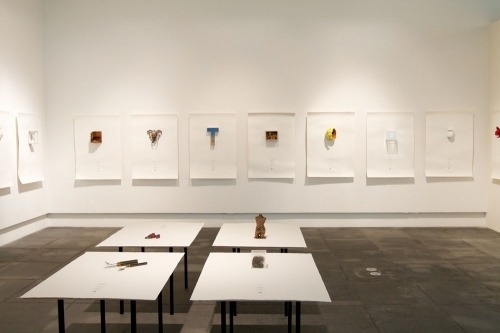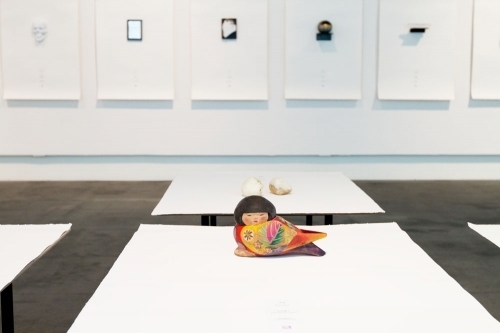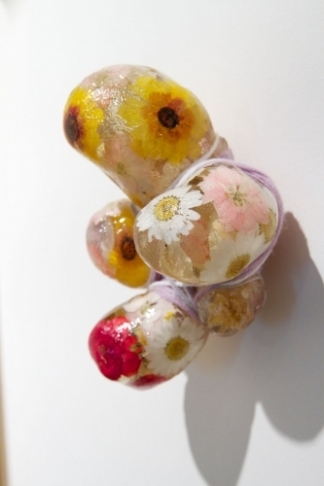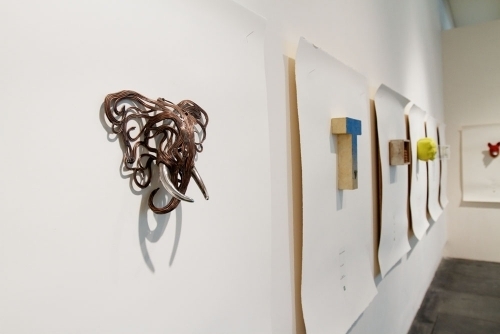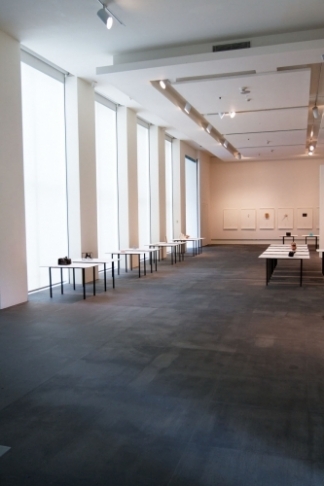2011Haiku-Sculpture : International Exhibition for Art Academies
2011.05.06~2011.06.19
09:00 - 17:00
Haiku-Sculpture 2011: International Exhibition for Art Academies May 6th –June 19th, 2011 Concept Haiku-Sculpture2011 is an international exhibition for art academies, with the participation of twenty prominent art academies/universities in Asia, which are from Japan, Korea, China, Thailand and Taiwan, hosted by the School of Fine Arts of Taipei National University of the Arts (TNUA). The 1st to 3rd Haiku Sculpture were hosted by Okinawa Prefectural University of Arts in Okinawa (OPUA), Japan. Haiku-Sculpture 2011: International Exhibition for Art Academies will be the 4th exhibition, co-curated by OPUA and TNUA, and will be taken place in TNUA in Taipei, Taiwan. The exhibition is not only intended to establish itself as an interactive platform for Asian arts and culture exchange, also to enhance the collaboration of transnational communities from Northeast to Southeast Asia, as well as in searching for the possibilities of sculptural expression in new relevant to the national and the global. In addition, for double featuring the exhibition, an international forum for Haiku Sculpture will be held after the opening day of the
Haiku Sculpture 2011”. The core concept of Haiku-Sculpture stems from
Haiku-form”. By converting the 5-7-5-syllables format of Haiku onto the size 5 ×7 ×5 inches of sculpture artworks, the exhibition means to refine the infinite from the finite, as well as to create possibilities of sculptural expression, and to expand the sculpture art into a new realm. Haiku, a classical Japanese poetry,” is a poem composed in a three-line format of 5-7-5 syllables” (Haiku Image Sculpture, 2006, p.5). Haiku is the shortest poetry in the world, though, it regards as
an epitome of a whole tranche of Japanese culture” (Haiku-Sculpture 2009, p.). Within the most restrict and smallest form of Haiku, the essence of Japanese culture has been revealed. The original conceiving of Haiku-Sculpture came from Okinawa Prefectural University of Arts, the Professor Kamijo Fumiho. From the 1st through 3 rd Haiku-Sculpture Exhibition were hosted by Okinawa Prefectural University of Arts in Okinawa, Japan as well. Haiku-Sculpture 2011: International Exhibition for Art Academies will be the 4th exhibition, which will be held by TNUA in Taipei, Taiwan. The exhibition not only stresses on the notion of different levels of
from finite to infinite” and
from two dimension onto three dimension”, but also to transcend the boundary of those planes in a given space. Furthermore, in the displaying venue, how a limit space can shape and model the limitlessness to by transforming the spirits of Haiku to the creation of sculpture in a diverse aspects where the old and the new, the tradition and modern, the writing and the carving, the vertical plane and the horizontal plane, and finally the literature and sculpture all contain within. Taken together, the exhibition of Haiku-Sculpture 2011 provides a framework to interpret the in-between-spaces of the sculpture in manifesting its creating-recreating dimensions. Haiku Sculpture 2011 will surly be a brand-new experience for all participating artists. In echoing the 4th edition of Haiku-Sculpture 2011, an International Forum for Haiku-Sculpture 2011 will be held on 7 May, 2011, and willplay an active role in active discussing and referencing from the local by sharing and shaping the diverse experiences from the participants of different cultures. Sites visits, talks, and forums are organized in exploring the collective experience in attending and thus reinventing the realm of sculpture. The 4th Haiku-Sculpture Exhibition 2011is an attempt tostretch different artistic-cultural dimension traversing through the art by bringing together art teachers and students from Northeast through Southeast Asia to beget a forum in the realm of sculpture.
Haiku Sculpture 2011”. The core concept of Haiku-Sculpture stems from
Haiku-form”. By converting the 5-7-5-syllables format of Haiku onto the size 5 ×7 ×5 inches of sculpture artworks, the exhibition means to refine the infinite from the finite, as well as to create possibilities of sculptural expression, and to expand the sculpture art into a new realm. Haiku, a classical Japanese poetry,” is a poem composed in a three-line format of 5-7-5 syllables” (Haiku Image Sculpture, 2006, p.5). Haiku is the shortest poetry in the world, though, it regards as
an epitome of a whole tranche of Japanese culture” (Haiku-Sculpture 2009, p.). Within the most restrict and smallest form of Haiku, the essence of Japanese culture has been revealed. The original conceiving of Haiku-Sculpture came from Okinawa Prefectural University of Arts, the Professor Kamijo Fumiho. From the 1st through 3 rd Haiku-Sculpture Exhibition were hosted by Okinawa Prefectural University of Arts in Okinawa, Japan as well. Haiku-Sculpture 2011: International Exhibition for Art Academies will be the 4th exhibition, which will be held by TNUA in Taipei, Taiwan. The exhibition not only stresses on the notion of different levels of
from finite to infinite” and
from two dimension onto three dimension”, but also to transcend the boundary of those planes in a given space. Furthermore, in the displaying venue, how a limit space can shape and model the limitlessness to by transforming the spirits of Haiku to the creation of sculpture in a diverse aspects where the old and the new, the tradition and modern, the writing and the carving, the vertical plane and the horizontal plane, and finally the literature and sculpture all contain within. Taken together, the exhibition of Haiku-Sculpture 2011 provides a framework to interpret the in-between-spaces of the sculpture in manifesting its creating-recreating dimensions. Haiku Sculpture 2011 will surly be a brand-new experience for all participating artists. In echoing the 4th edition of Haiku-Sculpture 2011, an International Forum for Haiku-Sculpture 2011 will be held on 7 May, 2011, and willplay an active role in active discussing and referencing from the local by sharing and shaping the diverse experiences from the participants of different cultures. Sites visits, talks, and forums are organized in exploring the collective experience in attending and thus reinventing the realm of sculpture. The 4th Haiku-Sculpture Exhibition 2011is an attempt tostretch different artistic-cultural dimension traversing through the art by bringing together art teachers and students from Northeast through Southeast Asia to beget a forum in the realm of sculpture.
Haiku-Sculpture 2011: International Exhibition for Art Academies May 6th –June 19th, 2011 Concept Haiku-Sculpture2011 is an international exhibition for art academies, with the participation of twenty prominent art academies/universities in Asia, which are from Japan, Korea, China, Thailand and Taiwan, hosted by the School of Fine Arts of Taipei National University of the Arts (TNUA). The 1st to 3rd Haiku Sculpture were hosted by Okinawa Prefectural University of Arts in Okinawa (OPUA), Japan. Haiku-Sculpture 2011: International Exhibition for Art Academies will be the 4th exhibition, co-curated by OPUA and TNUA, and will be taken place in TNUA in Taipei, Taiwan. The exhibition is not only intended to establish itself as an interactive platform for Asian arts and culture exchange, also to enhance the collaboration of transnational communities from Northeast to Southeast Asia, as well as in searching for the possibilities of sculptural expression in new relevant to the national and the global. In addition, for double featuring the exhibition, an international forum for Haiku Sculpture will be held after the opening day of the
Haiku Sculpture 2011”. The core concept of Haiku-Sculpture stems from
Haiku-form”. By converting the 5-7-5-syllables format of Haiku onto the size 5 ×7 ×5 inches of sculpture artworks, the exhibition means to refine the infinite from the finite, as well as to create possibilities of sculptural expression, and to expand the sculpture art into a new realm. Haiku, a classical Japanese poetry,” is a poem composed in a three-line format of 5-7-5 syllables” (Haiku Image Sculpture, 2006, p.5). Haiku is the shortest poetry in the world, though, it regards as
an epitome of a whole tranche of Japanese culture” (Haiku-Sculpture 2009, p.). Within the most restrict and smallest form of Haiku, the essence of Japanese culture has been revealed. The original conceiving of Haiku-Sculpture came from Okinawa Prefectural University of Arts, the Professor Kamijo Fumiho. From the 1st through 3 rd Haiku-Sculpture Exhibition were hosted by Okinawa Prefectural University of Arts in Okinawa, Japan as well. Haiku-Sculpture 2011: International Exhibition for Art Academies will be the 4th exhibition, which will be held by TNUA in Taipei, Taiwan. The exhibition not only stresses on the notion of different levels of
from finite to infinite” and
from two dimension onto three dimension”, but also to transcend the boundary of those planes in a given space. Furthermore, in the displaying venue, how a limit space can shape and model the limitlessness to by transforming the spirits of Haiku to the creation of sculpture in a diverse aspects where the old and the new, the tradition and modern, the writing and the carving, the vertical plane and the horizontal plane, and finally the literature and sculpture all contain within. Taken together, the exhibition of Haiku-Sculpture 2011 provides a framework to interpret the in-between-spaces of the sculpture in manifesting its creating-recreating dimensions. Haiku Sculpture 2011 will surly be a brand-new experience for all participating artists. In echoing the 4th edition of Haiku-Sculpture 2011, an International Forum for Haiku-Sculpture 2011 will be held on 7 May, 2011, and willplay an active role in active discussing and referencing from the local by sharing and shaping the diverse experiences from the participants of different cultures. Sites visits, talks, and forums are organized in exploring the collective experience in attending and thus reinventing the realm of sculpture. The 4th Haiku-Sculpture Exhibition 2011is an attempt tostretch different artistic-cultural dimension traversing through the art by bringing together art teachers and students from Northeast through Southeast Asia to beget a forum in the realm of sculpture.
Haiku Sculpture 2011”. The core concept of Haiku-Sculpture stems from
Haiku-form”. By converting the 5-7-5-syllables format of Haiku onto the size 5 ×7 ×5 inches of sculpture artworks, the exhibition means to refine the infinite from the finite, as well as to create possibilities of sculptural expression, and to expand the sculpture art into a new realm. Haiku, a classical Japanese poetry,” is a poem composed in a three-line format of 5-7-5 syllables” (Haiku Image Sculpture, 2006, p.5). Haiku is the shortest poetry in the world, though, it regards as
an epitome of a whole tranche of Japanese culture” (Haiku-Sculpture 2009, p.). Within the most restrict and smallest form of Haiku, the essence of Japanese culture has been revealed. The original conceiving of Haiku-Sculpture came from Okinawa Prefectural University of Arts, the Professor Kamijo Fumiho. From the 1st through 3 rd Haiku-Sculpture Exhibition were hosted by Okinawa Prefectural University of Arts in Okinawa, Japan as well. Haiku-Sculpture 2011: International Exhibition for Art Academies will be the 4th exhibition, which will be held by TNUA in Taipei, Taiwan. The exhibition not only stresses on the notion of different levels of
from finite to infinite” and
from two dimension onto three dimension”, but also to transcend the boundary of those planes in a given space. Furthermore, in the displaying venue, how a limit space can shape and model the limitlessness to by transforming the spirits of Haiku to the creation of sculpture in a diverse aspects where the old and the new, the tradition and modern, the writing and the carving, the vertical plane and the horizontal plane, and finally the literature and sculpture all contain within. Taken together, the exhibition of Haiku-Sculpture 2011 provides a framework to interpret the in-between-spaces of the sculpture in manifesting its creating-recreating dimensions. Haiku Sculpture 2011 will surly be a brand-new experience for all participating artists. In echoing the 4th edition of Haiku-Sculpture 2011, an International Forum for Haiku-Sculpture 2011 will be held on 7 May, 2011, and willplay an active role in active discussing and referencing from the local by sharing and shaping the diverse experiences from the participants of different cultures. Sites visits, talks, and forums are organized in exploring the collective experience in attending and thus reinventing the realm of sculpture. The 4th Haiku-Sculpture Exhibition 2011is an attempt tostretch different artistic-cultural dimension traversing through the art by bringing together art teachers and students from Northeast through Southeast Asia to beget a forum in the realm of sculpture.
Japan Joshibi University of Art and Design
Tama Art University
Okinawa Prefectural University of Arts
Tokyo Zokei University
Tokyo University of the Arts
Kanazawa College of Art
Aichi Prefectural University of Fine Arts and Music
Hiroshima City University
Thailand
Chiang Mai University, Thailand
Taiwan
School of Fine Arts, Taipei National University of the Arts
Department of Plastic Arts, Dayeh University
Department of Fine Arts, Tunghai University
Graduate Institute of Plastic Arts, Tainan National University of the Arts
Graduate Institute of Applied Arts, Tainan National University of the Arts
Department of Sculpture, National Taiwan University of Arts
Department of Motion Pictures and video, Kun Sun University
South Korea
Chung Ang University, Korea
HongIk University
Chonnam National University
College of Fine Arts, Seoul National University
College of Fine Art, Sung Shin Women’s University
Korea National University of Arts
China
China Central Academy of Fine Arts
Department of Sculpture, China Academy of Art
Jilin Animation College
Harbin Normal University, China
Luxun Academy of Fine Art
Tama Art University
Okinawa Prefectural University of Arts
Tokyo Zokei University
Tokyo University of the Arts
Kanazawa College of Art
Aichi Prefectural University of Fine Arts and Music
Hiroshima City University
Thailand
Chiang Mai University, Thailand
Taiwan
School of Fine Arts, Taipei National University of the Arts
Department of Plastic Arts, Dayeh University
Department of Fine Arts, Tunghai University
Graduate Institute of Plastic Arts, Tainan National University of the Arts
Graduate Institute of Applied Arts, Tainan National University of the Arts
Department of Sculpture, National Taiwan University of Arts
Department of Motion Pictures and video, Kun Sun University
South Korea
Chung Ang University, Korea
HongIk University
Chonnam National University
College of Fine Arts, Seoul National University
College of Fine Art, Sung Shin Women’s University
Korea National University of Arts
China
China Central Academy of Fine Arts
Department of Sculpture, China Academy of Art
Jilin Animation College
Harbin Normal University, China
Luxun Academy of Fine Art
Japan Joshibi University of Art and Design
Tama Art University
Okinawa Prefectural University of Arts
Tokyo Zokei University
Tokyo University of the Arts
Kanazawa College of Art
Aichi Prefectural University of Fine Arts and Music
Hiroshima City University
Thailand
Chiang Mai University, Thailand
Taiwan
School of Fine Arts, Taipei National University of the Arts
Department of Plastic Arts, Dayeh University
Department of Fine Arts, Tunghai University
Graduate Institute of Plastic Arts, Tainan National University of the Arts
Graduate Institute of Applied Arts, Tainan National University of the Arts
Department of Sculpture, National Taiwan University of Arts
Department of Motion Pictures and video, Kun Sun University
South Korea
Chung Ang University, Korea
HongIk University
Chonnam National University
College of Fine Arts, Seoul National University
College of Fine Art, Sung Shin Women’s University
Korea National University of Arts
China
China Central Academy of Fine Arts
Department of Sculpture, China Academy of Art
Jilin Animation College
Harbin Normal University, China
Luxun Academy of Fine Art
Tama Art University
Okinawa Prefectural University of Arts
Tokyo Zokei University
Tokyo University of the Arts
Kanazawa College of Art
Aichi Prefectural University of Fine Arts and Music
Hiroshima City University
Thailand
Chiang Mai University, Thailand
Taiwan
School of Fine Arts, Taipei National University of the Arts
Department of Plastic Arts, Dayeh University
Department of Fine Arts, Tunghai University
Graduate Institute of Plastic Arts, Tainan National University of the Arts
Graduate Institute of Applied Arts, Tainan National University of the Arts
Department of Sculpture, National Taiwan University of Arts
Department of Motion Pictures and video, Kun Sun University
South Korea
Chung Ang University, Korea
HongIk University
Chonnam National University
College of Fine Arts, Seoul National University
College of Fine Art, Sung Shin Women’s University
Korea National University of Arts
China
China Central Academy of Fine Arts
Department of Sculpture, China Academy of Art
Jilin Animation College
Harbin Normal University, China
Luxun Academy of Fine Art
